”The three goddesses (Hera, Athena, and Aphrodite) asked Zeus to present the apple of discord — a beautiful gold sphere — to the one who deserved the title kallista ‘most beautiful’. I know some of the other gods were surprised Zeus couldn’t bring himself to admit the obvious, but I understood. How could he choose an adopted daughter over the product of his own body or his wife? His home life would have been unbearable. And don’t give me any of that beauty is in the eye of the beholder stuff: Aphrodite was exquisite. No two ways about it. Even if she weren’t, her magic girdle would have made everyone see her as such.But honor was never Zeus’ strong suit. Torturing mankind was.”
Helen of Troy is quite possibly one of the most inspired characters of all time, including modern and ancient literature. She has become a symbol of man’s erotic desires and of all of the varied moods of womanhood . The ancient myth that forever associates her with beauty and the Trojan War was first recorded in written language by Homer, but continues to be written about today. Her story is one that is intricately intertwined with many of the Greek gods and goddesses.Helen of Troy was referred to as ” The most beautiful woman who ever lived” and “The Face that launched a Thousand Ships”. The Trojan War resulted when Paris, the prince of Troy carried her off during the reign of her husband the Spartan King Menelaus.
The beginnings of the story of Helen have little to do with her personally. As was characteristic of Greek mythology and the interactions of the deities with their human counterparts, she was never more than a puppet in various heavenly battles, beginning with three goddesses, and then stretching to include all of the deities on Olympus, the place in the sky from where the gods and goddesses reigned.

''Aphrodite by Claude Verlinde I brought this up in a different thread and thought I'd share it in it's own thread. Years ago I read about the Church of Aphrodite, or the Temple of Aphrodite. It was in The New Pagans by Hans Holzer. It described their "Communion" ritual as follows. A skyclad man and woman both sit on the altar and honey is poured over their genitals. The circle participants each partake of the honey from either or both of the "sacrifices". So, the question is...Would you sit on Aphrodite's altar? I most certainly would. :)''
There were too many contradictions to sustain the lie. No one has ever found any evidence that the Greeks ever fought at Troy. Homer and his account of the Trojan War in the Iliad and the Odyssey did not bail out one ounce of water in for the beauty that launched a thousand ships fame. But does it matter? The mythical imagination did not come to an end with the Iliad and the Odyssey, but went on creating new variations and combinations and morphed into a revision of old traditions which Homer failed to include.
The Gods played an active part all through the story. But in order to retain the ”human” side as actual history, scholars have found it necessary to disregard such divine interventions as poetic license or allegory or irrelevant pagan superstition. The story does not make much sense according to the time lines; its as if time stood still while everyone waited passively for the war to end. Stripped of the magic of its poetry and richness of detail, the Homeric tale has little substance which is credible.
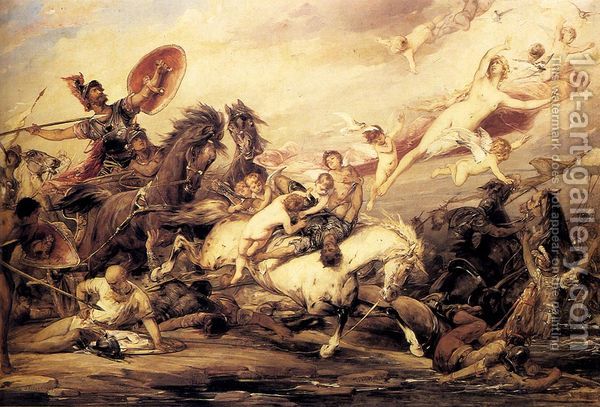
Handmade oil painting reproduction of Icarius (Diomedes Wounding Aphrodite When She Tries To Recover The Body Of Aeneas), a painting by Arthur Heinrich Wilhelm Fitger.
”Anyway, like Athena and Hera, Aphrodite went along with Zeus’ plan, but in her case, it was because she could use it to remind Tyndareus of his transgression: She promised Tyndareus’ adopted daughter Helen to Paris if he would choose her. Since Helen, my daughter, was the most beautiful woman anywhere, Paris could not and did not resist. After Paris awarded Aphrodite the apple, he and Helen eloped back to his homeland, Troy, and the Trojan War began. The ten years of bloodshed were all Aphrodite’s (and Zeus’) fault, yet all she suffered was a little flesh wound when Diomedes nicked her milk white hand.”
The real impact of Homer, was his ability to capture the imagination; and as such he is responsible for the way poetry became converted to history. The emergence of myth and symbols, a world of illusion, fantasy and fairyland is what has been the enthralling aspect aspect of the work, a crucial event in what anthropologists would call ”the making of meaning”. George Grote had no hesitation in calling the whole Trojan story an ”interesting fable”, despite its great appeal.
The view reflected by Grote was becoming predominant until Schliemann turned the tide with his archaeological discoveries. He seized upon the idea that Troy lay buried within an 85- foot high mound in the northwestern corner of Turkey, about four miles from the Aegean Sea. He began to dig there in 1870 and at one found fortification walls. Soon he produced incontrovertible proof that this location, Hissarlik, had been an important citadel with a long history, unearthing, among other things, weapons, jewelry, and gold and silver objects.
Six years later Schliemann tried the same tack in Greece, and struck gold when he uncovered the Shaft Graves with their remarkable treasures. In his mind, that was double proof, material proof, of the Homeric tales; that was the ”independent evidence” , the lack of which men like Grote had made so much of. In the ensuing decades Schliemann’sarguments, supported by further discoveries, won over just about everyone. Like Werner Keller in his ”Bible as History”, he seemed to have found the right bones in the yard. It can no longer be doubted that Hissarlik is the Troy of legend.
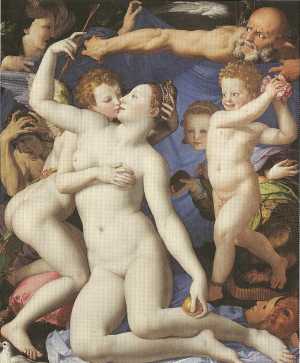
Name:"Allegory of Love" Museum:National Gallery, London, England Artist and Year:Bronzino,ca.1545 Theme:Goddess Aphrodite in an intimate scene with Eros, in a painting symbolizing carnal Love.
However, it is necessary to be equally clear about what archaeology has not substantiated. The Homeric description of the site of Troy is sufficiently unlike the actual site. Also, the difficulties with the date of the war are more unsettling. The two great treasures that Schliemann found at Troy and in Greece at Mycenae, belong to the wrong civilization. The war which lay at the core of the tradition could not have occurred at the time when either of the two ”treasures” were deposited. And the Shaft Treasure of Mycenae is also too early to correspond to the War. In any event, Troy VI was destroyed by massive destruction in the time frame given, but it was the result of an earthquake.
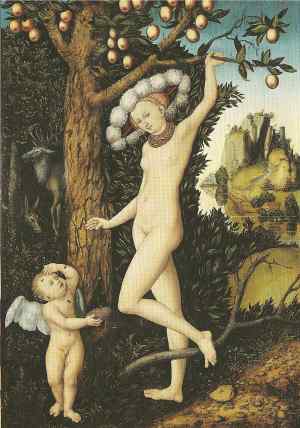
Lucas Cranach. Name:"Aphrodite and Eros" Museum:National Gallery, London, England Artist and Year:Lucas Cranach Sr.,ca. 1430 Theme:Aphrodite talks with her son Eros, who has been stung by bees.
Troy VI was immediately followed by a shabby, impoversihed community huddled in one small sector of the ridge, as unlike the Homeric picture of the large and wealthy city of Priam as one could imagine. Nothing has been found, however, and it is necessary to stress that ”nothing” is to be understood to be literally, not a single scrap, that points to who the destroyers were. In other wods, Trojan archaeology has not been able to substantiate the Homeric tales on this most essential point, despite repeated assertions by archaeologists and historians to the contrary. Mycenaean has also failed the challenge of proving or pointing to an explicit example of a Trojan War or Troy.
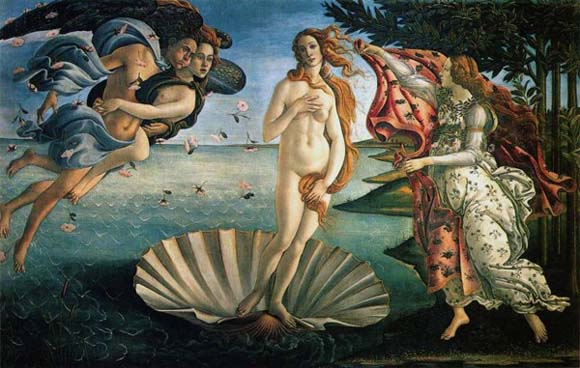
Aphrodite was painted by Sandro Botticelli. Its title is The birth of Venus. (Venus was the Roman name for the Greek goddess Aphrodite.)
Our only ground for thinking that there was a Trojan War remains the old tradition, and the motives for such a complicated overseas expedition still have to be explained. Romanticism aside, it is doubtful the abduction of Helen is an acceptable reason even allowing for poetic exaggeration. For the later Greeks, they held that Agamemnon, Odysseus and Achilles were essentially Greeks like themselves . They were however, more heroic and at the same time more primitive, and that is why they could be permitted to organize an otherwise incredibly massive expedition ”for the sake of a simple Spartan girl”.
As implausible as all this is, the great majority of scholars still prefer to hold to this tradition, at least to its core. The Iliad and the Odyssey, it is pointed out, are the greatest examples of heroic poetry, a genre known in many parts of the world. Heroic poetry is composed orally, the work of illiterate but highly skilled and professional bards who are able to transmit long and complicated tales from generation to generation. The medieval Grand Prince of Kiev was still being sung about in the twentieth century, as was the battle of Kosoveo at which the Ottoman turks administered a shattering defeat to the Serbs in 1389.
And the twentieth century poems contain an element of historical truth on both themes. Therefore, the argument goes, the Iliad and Odyssey, composed with a genius which the Slavic bards cannot approach, must also have a large historical kernel, and even a much more considerable one.
But if the Serbian bards could invent tales about the main hero at the battle of Kosovo, and if the French song of Roland can get the enemy wrong, and if the German ”Nibelungenlied” can get just about everything wrong; if the Homeric poems contradict most of what we know about the actual working of Mycenaean society, and if their Troy,though in the right place, bears little resemblance to the archaeologists’ Troy, and if they are unable to prove a reasonable account of it- then how can one tell what bits, if any, are historical?
In the end, one must return to the genius of the Iliad and the Odyssey. No one reads Virgil’s ”Aenid” of King Lear as true stories, as people once did. We certainly do not try to write medieval French history from the ”Song of Roland” or medieval German history from the ”Nibelungenlied”. Why should we make an exception of Homer’s Trojan War? The answer lies in its metaphorical truth and its metaphysical component;part of larger battle of humanity, but within similar contexts that explore the nature of extremes and a broader debate on gender….
It is interesting to consider the qualities of beauty. They include truth, harmony, love, attractiveness, and delight. These are qualities that are to be important in the later idealism of the Greeks. In contrast war is anything but beautiful. It is almost the opposite. Though Aphrodite is the goddess of love and beauty she marries Ares, the god of war. It is as though these two opposites are warring for the attention of the souls who devote their lives to this contest. For the Trojan War is not just a battle for Troy, it is a battle of the gods for life itself and the souls of those who live it. And the stories that are generated are not just an adventure. They are an elaboration of the path a soul must take to participate in what is holy. It is, in truth, a story about what life is about and how to make it worthwhile.
The fact that a woman is the center of this story suggests that women are important and not secondary. In fact they are central to the whole scheme. But this was an embarrassment to the Greek men. The two sides of the Trojan conflict were not Ares and Aphrodite, they were Aphrodite and Athena. It was also an opposition of passion and reason. Worse yet Aphrodite is aligned against Athena and Hera. It is the story of the Judgement of Paris that one must read to get the full gist of this.
The story of Helen’s birth is not that important to the Trojan tale but it does reinforce the cosmic nature of the story. The story is that Helen was hatched from an egg. This seems related to myths that occur in other cultures about a wind egg that produces creation. In this case the egg creates the world of the Trojan War. It was Zeus that decided to have sex with Leda as a swan to produce this egg.
A poem by the feminist poet H.D. depicting Helen of Troy:
All Greece hates
the still eyes in the white face,
the lustre of olives
where she stands,
and the white hands.
All Greece reviles
the wan face when she smiles,
hating it deeper still
when it grows wan and white,
remembering past enchantments
and past ills.
Greece sees unmoved,
God’s daughter, born of love,
the beauty of cool feet
and slenderest knees,
coul love indeed the maid,
only if she were laid,
white ash amid funereal cypresses.
The Romans originally worshiped Venus as goddess of fertility. Her fertility powers spread from the garden to humans. The Greek aspects of the love and beauty goddess Aphrodite were added on to Venus’ attributes, and so for most practical purposes, Venus is synonymous with Aphrodite. The Romans revered Venus as the ancestor of the Roman people through her liaison with Anchises.
“She was the goddess of chastity in women, despite the fact that she had many affairs with both gods and mortals. As Venus Genetrix, she was worshiped as the mother (by Anchises) of the hero Aeneas, the founder of the Roman people; as Venus Felix, the bringer of good fortune; as Venus Victrix, the bringer of victory; and as Venus Verticordia, the protector of feminine chastity. Venus is also a nature goddess, associated with the arrival of spring. She is the bringer of joy to gods and humans. Venus really had no myths of her own but was so closely identified with the Greek Aphrodite that she “took over” Aphrodite’s myths.”


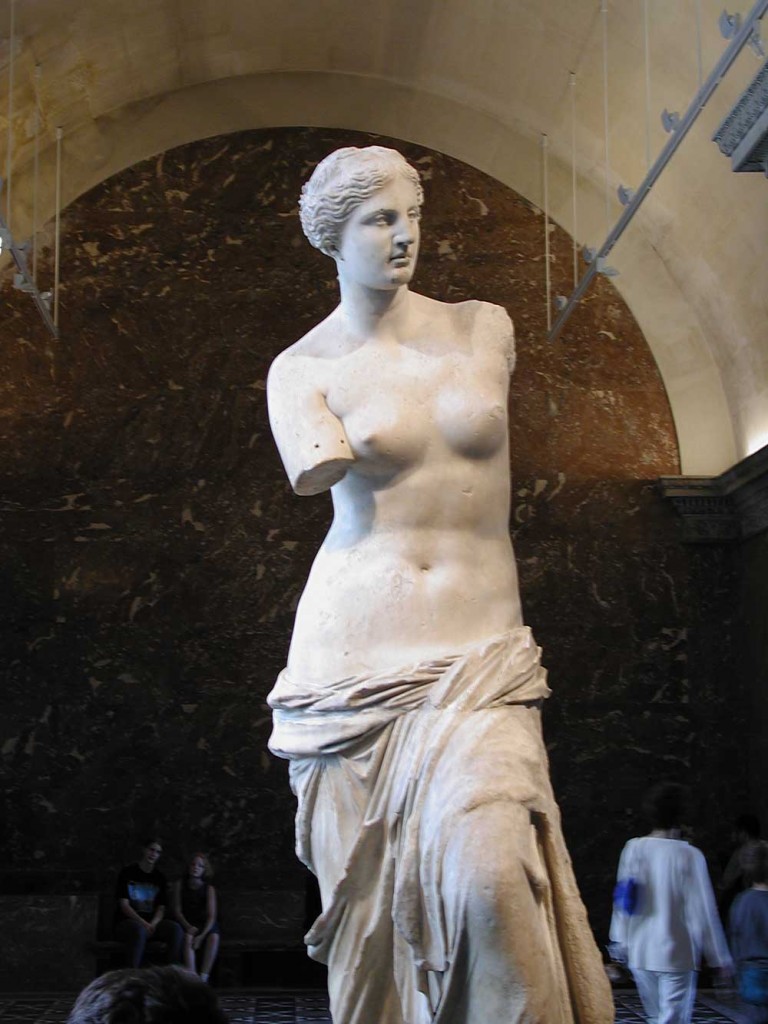

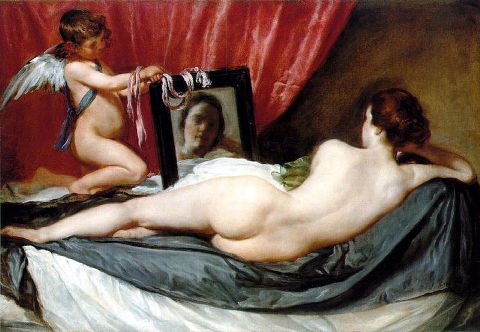
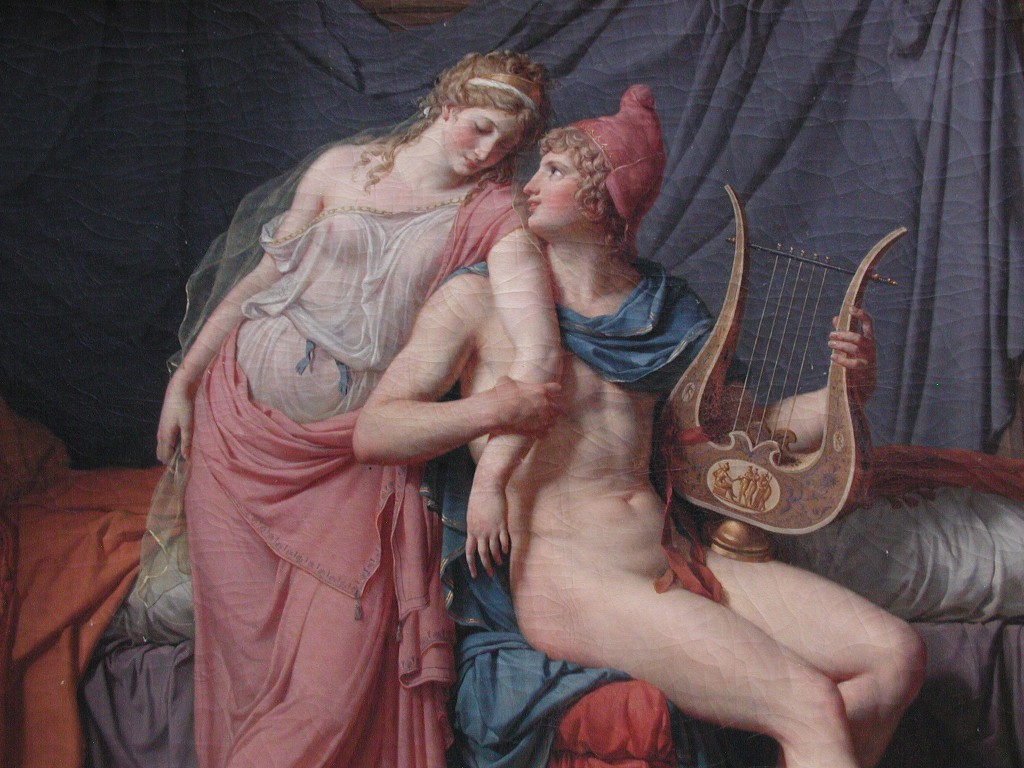
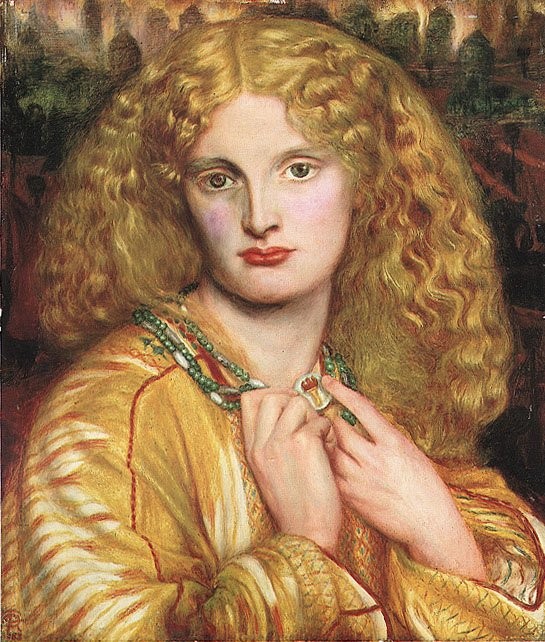



 COMMENTS
COMMENTS